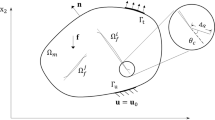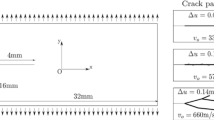Abstract
Dynamic crack growth and branching of a running crack under various biaxial loading conditions in homogeneous and heterogeneous brittle or quasi-brittle materials is investigated numerically using RFPA2D (two-dimensional rock failure process analysis)-Dynamic program which is fully parallelized with OpenMP directives on Windows. Six 2D models were set up to examine the effect of biaxial dynamic loading and heterogeneity on crack growth. The numerical simulation vividly depicts the whole evolution of crack and captured the crack path and the angles between branches. The path of crack propagation for homogenous materials is straight trajectory while for heterogeneous materials is curved. Increasing the ratio of the loading stress in x-direction to the stress in y-direction, the macroscopic angles between branches become larger. Some parasitic small cracks are also observed in simulation. For heterogeneous brittle and quasi-brittle materials coalescence of the microcracks is the mechanism of dynamic crack growth and branching. The crack tip propagation velocity is determined by material properties and independent of loading conditions.
Similar content being viewed by others
References
Adda-Bedia M (2005) Brittle fracture dynamics with arbitrary paths III. The branching instability under general loading. J Mech Phys Solids 53: 227–248
Belytschko T, Black T (1999) Elastic crack growth in finite elements with minimal remeshing. Int J Numer Methods Eng 45: 601–620
Belytschko T, Chen H, Xu J, Zi G (2003) Dynamic crack propagation based on loss of hyperbolicity with a new discontinuous enrichment. Int J Numer Meth Eng 58: 1873–1905
Bowden FP, Brunton JH, Field JE, Heyes AD (1967) Controlled fracture of brittle solids and interruption of electrical current. Nature 216: 38–42
Cox BN, Gao H, Gross D, Rittel D (2005) Modern topics and challenges in dynamic fracture. J Mech Phys Solids 53: 565–596
Eshelby JD (1970) Energy relations and the energy-momentum tensor in continuum mechanics. In: Kanninen MF, Adler WF, Rosenfield AR, Jaffee RI (eds) Inelastic behaviour of solids. pp 77–144
Fedelinsky P, Aliabadi MH (1997) The time-domain dbem for rapidly growing cracks. Int J Numer Methods Eng 40: 1555–1572
Freund LB (1998) Dynamic fracture mechanics. Cambridge University Press, Cambridge
Ha YD, Bobaru F (2011) Characteristics of dynamic brittle fracture captured with peridynamics. Eng Fract Mech 78: 1156–1168
Hawong JS, Kobayashi AS, Dadkhah MS, Kang BSJ, Ramulu M (1987) Dynamic crack curving and branching under biaxial loading. Exp Mech 27: 146–153
Kalthoff JF (1973) On the propagation direction of bifurcated cracks. In: Sin GC (ed) Dynamic crack propagation. Noordhoff, Leyden, pp 449–458
Murphy N, Ali M, Ivankovic A (2006) Dynamic crack bifurcation in PMMA. Eng Fract Mech 73: 2569–2587
Nishioka T (2010) Advanced studies on simulation methodologies for very complicated fracture phenomena. IOP Conf Ser Mater Sci Eng 10:012046. doi:10.1088/1757-899X/10/1/012046
Rafiee S, Seelig Th, Gross D (2003) Simulation of dynamic crack curving and branching under biaxial loading by a time domain boundary integral equation method. Int J Fract 120: 545–561
Ramulu M, Kobayashi AS (1985) Mechanics of crack curving and branching—a dynamic fracture analysis. Int J Fract 27: 187–201
Ravi-Chandar K, Knauss WG (1984a) An experimental investigation into dynamic fracture-I crack initiation and crack arrest. Int J Fract 25: 247–262
Ravi-Chandar K, Knauss WG (1984b) An experimental investigation into dynamic fracture-II Mi-crostructural aspects. Int J Fract 26: 65–80
Ravi-Chandar K, Knauss WG (1984c) An experimental investigation into dynamic fracture-III On steady-state crack propagation and crack branching. Int J Fract 26: 141–154
Ravi-Chandar K, Knauss WG (1984d) An experimental investigation into dynamic fracture-IV On the interaction of stress waves with propagating cracks. Int J Fract 26: 189– 200
Ravi-Chandar K, Yang B (1997) On the role of microcracks in the dynamic fracture of brittle materials. J Mech Phys Solids 45: 535–563
Réthoré J, Gravouil A, Combescure A (2004) A stable numerical scheme for the finite element simulation of dynamic crack propagation with remeshing. Comput Meth Appl Mech Eng 193: 42–44
Réthoré J, Gravouil A, Combescure A (2005) An energy conserving scheme for dynamic crack growth using the extended fnite element method. Int J Numer Meth Eng 63: 631–659
Schardin H (1959) Velocity effects in fracture. In: Averbach BL, Felbeck DK, Hahn GT, Thomas DA (eds) Fracture. Wiley, New York, pp 297–329
Sharon E, Fineberg J (1996) Microbranching instability and the dynamic fracture of brittle materials. Phys Rev B 54: 7128–7139
Sharon E, Fineberg J (1999) Confirming the continuum theory of dynamic brittle fracture for fast cracks. Nature 397: 333–335
Song JH, Areias PMA, Belytschko T (2006) A method for dynamic crack and shear band propagation with phantom nodes. Int J Numer Methods Eng 67: 868–893
Tada T, Yamashita T (1997) Nonhypersingular boundary integral equations for two-dimensional nonplanar crack analysis. Geophys J 130: 269–282
Tang CA (1997) Numerical simulation of progressive rock failure and associated seismicity. Int J Rock Mech Min Sci 34(2): 249–262
Xu XP, Needleman A (1994) Numerical simulation of fast crack growth in brittle solids. J Mech Phys Solids 42(9): 1397–1434
Yoffe E (1951) The moving griffith crack. Philos Mag 42: 739–750
Author information
Authors and Affiliations
Corresponding author
Rights and permissions
About this article
Cite this article
Zhang, Y.B., Tang, C.A., Li, H. et al. Numerical investigation of dynamic crack branching under biaxial loading. Int J Fract 176, 151–161 (2012). https://doi.org/10.1007/s10704-012-9731-1
Received:
Accepted:
Published:
Issue Date:
DOI: https://doi.org/10.1007/s10704-012-9731-1




